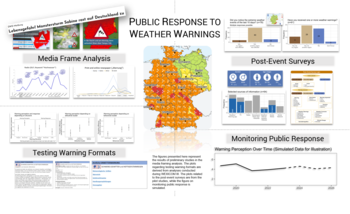WP 3: Public Response to Weather Warnings
Research Team:
WP 3 examines how effective weather warnings are in Germany and how different population groups respond to them. Previous studies often relied on hypothetical scenarios, yet actual behavior frequently deviates from intended behavior (intention-behavior gap; Sheeran & Webb, 2016). Therefore, we analyze real weather events to gain a profound understanding of the reception, perception, and response to weather warnings. This investigation follows four key steps:
- Post-Event Surveys
After two high-impact weather events, we conduct representative surveys to analyze who receives weather warnings, how they are perceived, and what reactions they trigger. - Media Frame Analysis
Socio-culturally embedded media coverage influences the perception of scientific information (Schäfer & O‘Neill, 2014). To assess this impact in Germany, we analyze how different media outlets report on the investigated weather events in parallel with the surveys. - Long-Term Monitoring of Changes
Previous studies (Schulze & Voss, 2022, 2023a) have shown a decline in trust in weather forecasts and satisfaction with warnings. To systematically track this development, standardized and validated questions on the perception of weather warnings are used and comparatively evaluated in both post-event studies and the investigation of warning formats. - Development of a Standardized Questionnaire and Analysis Tools
To enable post-event studies and long-term monitoring of attitudinal changes beyond the project duration, we develop a standardized questionnaire and program analysis codes for descriptive evaluation. The questionnaire and the analysis code will be made publicly available.
Additionally, in WP 3, we investigate ways to optimize the effectiveness of weather warnings, as warning-related factors are crucial for public perception and behavior (Schulze & Voss, 2022, 2023b). - Optimization of Weather Warning Formats
Based on insights from WEXICOM III and in collaboration with the German Weather Service (DWD), we develop various warning formats. These will be evaluated in a representative population survey to enhance the effectiveness of communication.
The findings contribute to the further development of weather forecasting and warning strategies and to a better understanding of the impact of weather warnings on different population groups.

